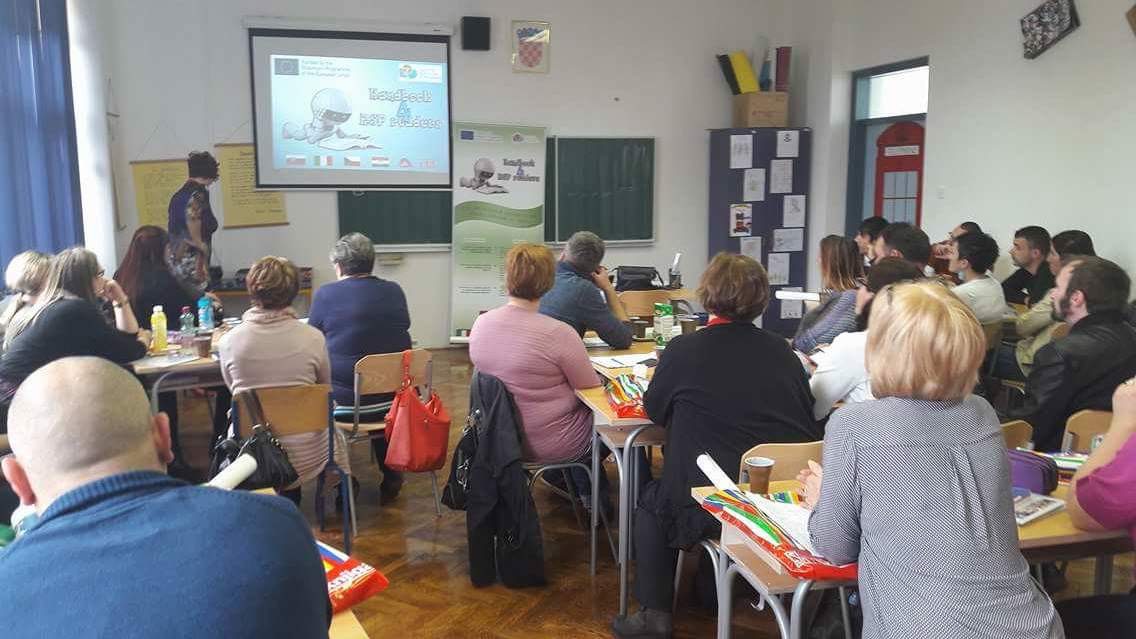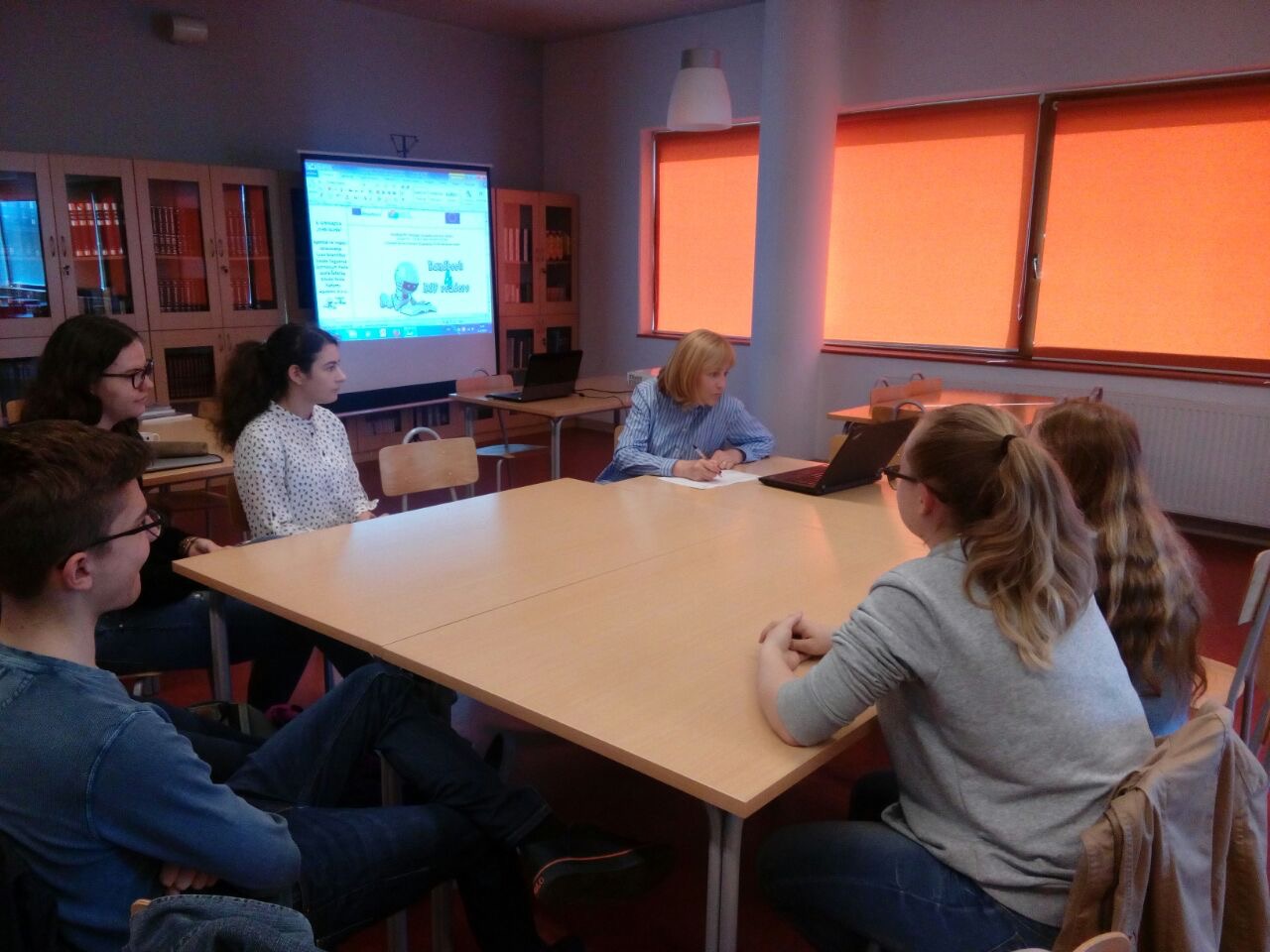
1. Case study
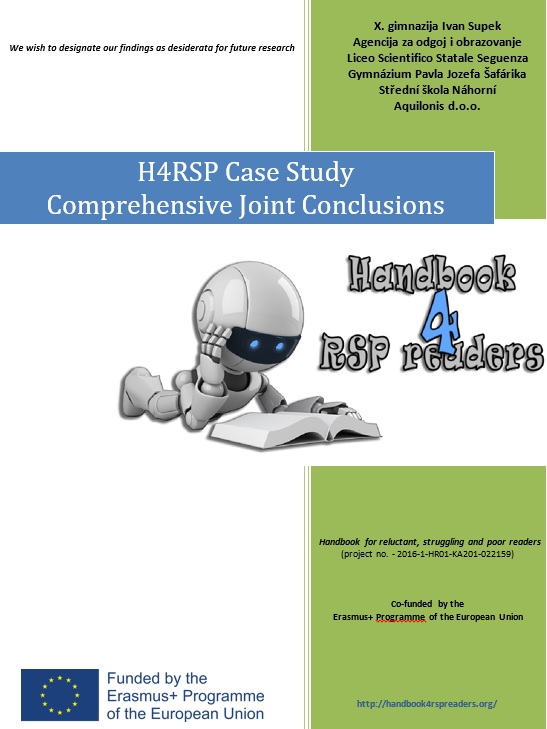 Project Case Study
Project Case Study
Main components of the Case Study derive from two project activities (O1.A1 & O2.A2.) carried out from October 2016 to April 2018, as well as from the partners reports on Critical Review and State of the Art within their country.
- CRITICAL REVIEW AND STATE OF THE ART
CROATIA
In the context of education, three literacy: reading, science and mathematics stand in the center of PISA research interests. The cycle of PISA 2015 was the sixth cycle of research and for the fourth time involving Republic of Croatia encompassing 5809 15-year-old respondents. In the field of reading literacy, the Republic of Croatia achieved below the average score of 487 points (31st place). By comparing the average results from reading literacy with the results of PISA 2009 cycle in Croatia, the trend of improvement of average results is noticed. In the six-year period, Croatia has increased the average score by 11 points.
In the PIRLS Survey, evaluating readership competences for ten years, Croatia participated in 2011. The results of Croatian students are significantly better than the results achieved in PISA research. But when it comes to reading, Croatia is in the foreground. In Croatia, only 17% of students love to read, 53% like it somehow, and 29% do not like reading. Of the 57 surveyed countries, Croatia has the largest percentage of children who do not like to read.
The relation of young people towards reading is largely determined by their school-based reading experiences. Unfortunatelly, school institutions of today does not perceive them as " “digital natives” (Prensky, 2001) growing up in the world of digital media where the image (rather than the word) often contains the basic meaning and is its frequent transferee.
In order to mediate the reading of all students aged 15-18 in Croatian schools, a mandatory corpus of literary texts is selected according to the criterion of importance and value within history of European (World) and National literature. This was determined in the mid-90s of the last century. The selected corpus of literary works by their contemporariness ends in the 1990s. For a large number of students, especially those who have defined themselves as RSP readers, these texts represent a serious problem with regard to their complexity. Reception of the texts is expected from all of the students during school interpretation and analysis. The problem begins allready at the level of basic understanding during independent reading, after which pupils are expected to collect and structure the information about text with regard to literary theory and history of literature.
The Government of the Republic of Croatia adopted the National Strategy for Reading (2015 - 2020) by following the proposal of the Ministry of Culture of the Republic of Croatia, with the aim of updating the problems and unification of various factors in society that deal with reading problems in one way or another.
In addition to the shorter programmes of teacher education at the level of individual counties, The Education and Teacher Training Agency organized IV. a symposium of teachers and teachers of Croatian language who was entirely dedicated to the reading entitled "Reading for School and Life".
Based on available information on reading promotion programs, it can be concluded that a large number of programs related to the promotion of reading are offered and implemented in Croatia. Motivated teachers and students who, in most cases have good developed reading skills and higher or high motivation to read are participating these programmes.
Unfortunately, the students we describe as reluctant, struggling and poor readers often remain outside those programmes.
SLOVAKIA
According to the PISA 2015 study Slovakia achieved 453 points in reading literacy; the average of the OECD countries was 493 points. As in all previous cycles, even in PISA 2015, the performance of Slovak pupils in reading literacy is below the average of the OECD participating countries. Compared to 2012, our pupils' average performance dropped by 10, which is not a significant change. There is a comparable number of our students in the PISA 2015 risk group (32.1%) to the 2012 cycle (28.2%). These pupils do not have even the most basic reading skills necessary for further education. Most pupils in the risk group are located in secondary vocational schools and elementary schools. Even in 4-year grammar schools, the proportion of pupils in the risk group has increased statistically significantly compared to the both previous cycles (2012 and 2009). There are great gender differences in reading literacy. Girls performed statistically better also in 2015 study, on average it was 27 points higher than boys in OECD countries. In Slovakia girls scored 36 points higher. In the 2003 and 2012 cycles the difference was roughly the same but in the last cycle it decreased by 11 points. As the difference narrows, we can see gradually growing score in boys´ performance and lower performance of girls. In Slovakia the performance of girls fell by 12 points compared to the previous cycles.
According to the study conducted by State school inspection in Slovakia up to 71,3% secondary schools have no strategy for development of reading literacy although according to the principles and objectives of secondary education, systematic work with texts is part of education in Slovakia. The same study emphasizes the importance of education of teachers. Education related to the reading literacy which is the important competence in understanding all subjects across the national curriculum. Another fact the study points out is that one of the main conditions for developing reading literacy is a book and an appropriate library. However, results show that almost half of the schools do not have suitable premises for a library and almost 24,09% of schools do not have a library at all.
ITALY
In compliance with the goals of Europe 2020 strategy, the Italian government has approved a reform on our educational system in order to shape and develop common European core skills in education and training: teachers should promote the acquisition of "key competences" that the European citizen should possess to meet the challenges of the everchanging and complex world that surrounds us, for example by addressing underachievement in maths, science and literacy through effective and innovative teaching and assessment. Therefore, our school, Liceo Scientifico "G. Seguenza", has carried out an analysis which has revealed a growing need for innovative teaching strategies in the field of languages, specifically, reading skills are to be prioritised. At the end of the year 2015, the Italian National Institute of statics ISTAT published the annual results provided by the survey conducted among the Italian population about their reading habits. People aged 6 and over were interviewed and 42% of them (about 24 million) stated that they had read at least one book in the 12 months preceding the interview for purposes other than school or work. Compared to the previous year, the percentage is stable, also considering the 2011 drop in reading habits. 9.1% of the Italian households do not own any books, 64.4% have 100 books at most. Gender differences are still evident: women read more than men, indeed, the figure for female readers was in fact 48.6%, compared to 35% for male readers. Book readers' share is over 50% among those aged 11 to 19; it shows a decrease in later age groups; the highest percentage of readers was found among the 15-17 age group. School is not enough. Family is a key factor: 66.8% of youngsters aged 6 to 14 with both parents who read books are book readers too, vs. only 30.9% of those whose parents do not read books. Book reading is less widespread in the South of Italy, where fewer than one out of three (28.8%) people has read at least one book. In Sicilia and Sardegna, readers are 33.1%: an increase as compared to 31.1% recorded in the previous year. In metropolitan centres book readers account for 51%, vs. 38.1% in areas with fewer than 2,000 inhabitants. Data confirm that nearly one reader out of two (45.5%) is a "weak" one, having read no more than three books in one year. The percentage of bookworms (people who read on average at least one book per month) is 13.7% of the readers (they were 14.3% in 2014). 8.2% of the total population (4.5 million) read or downloaded books or e:books, that is, 14.1% of those who surfed the Internet. Book reading and cultural participation are interrelated: among book readers, shares of those who practise other cultural activities and sports and surf the web are regularly higher than those of non-readers. Book readers also showed higher levels of satisfaction for their leisure time (71% vs. 64% of non-readers) and their economic situation (56% vs. 42%). Between 2011 and 2012, 37.8% of the foreign citizens living in Italy report they read at least one book. In 2014, Italian households spent 3,339 million euros for books and 5,278 for newspapers, printed matter and stationery: 11 and 18 euros per month, respectively, 0.4% and 0.6% of their total expenditure for final consumption. Between 2010 and 2014, household expenditure for books, newspapers and magazines decreased by 18%, that for stationery by 31%. That reduction is much higher than the one recorded by the expenditure for goods and services as a whole (6%).
CZECH REPUBLIC
According to the Czech Ministry of Education, reading literacy should be developed not only by teachers of Czech language and literature but it should be done within most of the subjects. All teachers need to use different sorts of texts for the purpose of teaching their subjects and students should be able to work with those texts – find relevant sources of information, read it, understand, find important information, compare, interpret the information, discuss the issue etc. Today, there are also loads of different sources and types of texts available – e.g. books, magazines, newspapers, school books, e-books, the internet etc. Students should be able to sort out the information coming from all the sides, work with the resources – compare and choose the most relevant information. The experts actually agree on the basic and simple approach which should be followed to make literature more attractive to pupils. We should stop ordering them to read books hundred years old far away from their interest and everyday life. It would be much easier to begin with books or stories they really like and, in the first place, make some space for analysing and discussing the texts. It is not necessary to work with books only; especially at the beginning with struggling or poor readers, we could use films, internet articles or even PC games as sources for analyses and discussions in the class. As we can read opinions of some teachers – it is possible to go this way and there are visible fruits of this work. The most important thing the teacher needs to start is the will to change something and to work hard especially at the beginning.
What we should also do is not to force pupils read more and more; instead, we should teach them how to like and enjoy reading; after that, they will be able to find the way themselves. Schools should serve as a kind of meeting point of literature with an ability to offer different sorts of interesting texts, providing a platform for discussion including experience and opinion exchange.
• Czech students regularly score lower than the average in PISA tests.
• Czech educational framework gives schools and teachers a chance to build up their own school educational programmes and approaches towards individual subjects; reading literacy is essential to gain the required key competencies and fulfil the expected outputs.
• Most teachers still follow the old chronological model of teaching literature – they start from the very beginning, spend a long time with the ancient literature, slowly move through every single century.
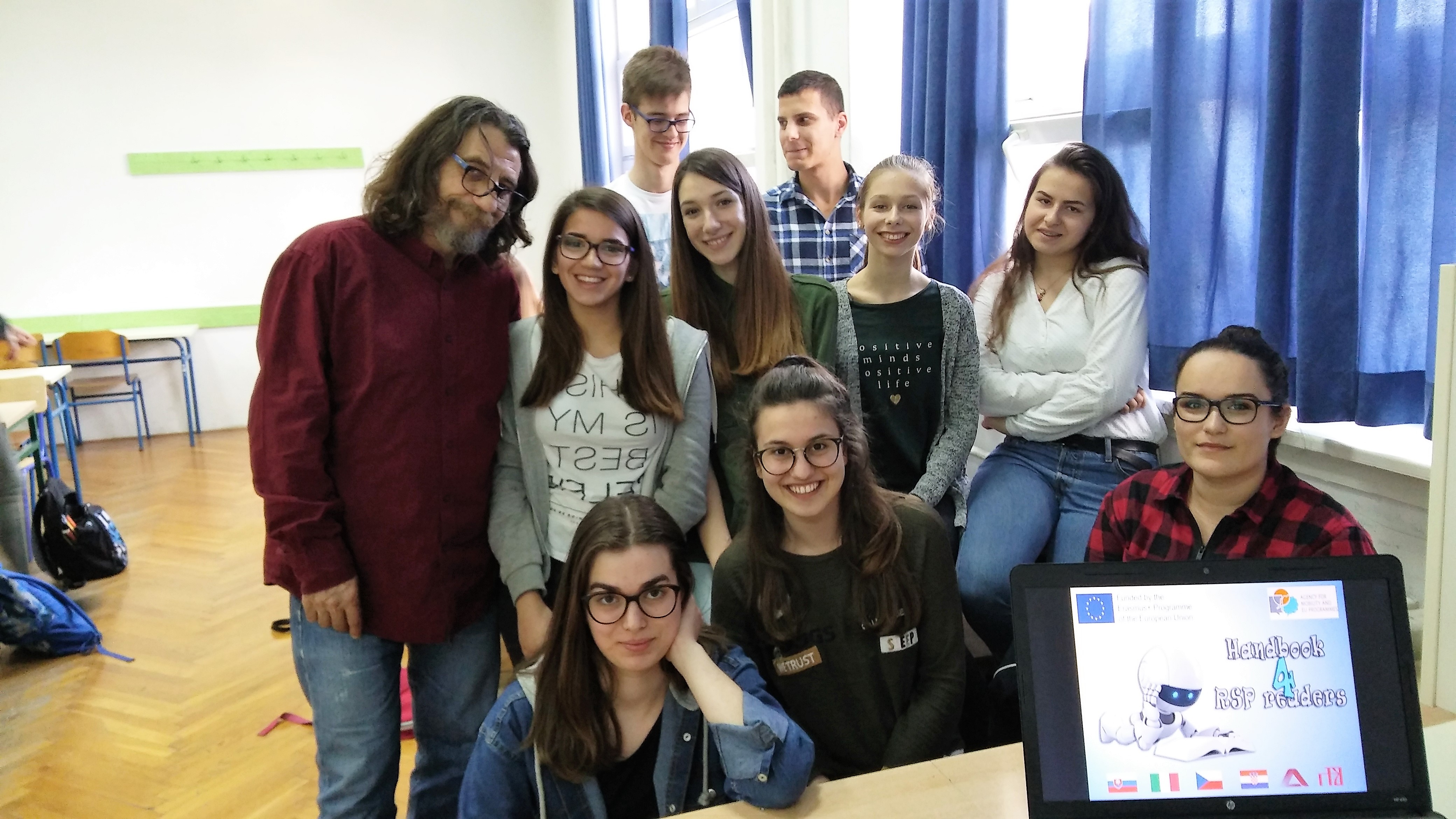
- O1.A1 Survey on reading competences focusing on student population aged 15 to 18 in 4 Partners countries: Italy, Slovakia, Czech Republic and Croatia
At the beginning of the two year Project course project partners carried out a qualitative Survey based of data collected by GoogleDocs tools. The Reading Habits Questionnaire was implemented and completed by 8248 high school students in 4 partner countries (Italy, Czech Republic, Slovakia and Croatia).
The Questionnaire examined the reading habits in high school population age 15 to 18, focusing primarily on identifying RSP Readers. The questions respondents were answering provided valuable informations on:
- Time the students dedicate to reading
- Type of literature as personall choice
- Reasons why they do not read more
- Incoming readpoints (e: books, journals, printed editions ...)
-
Relationship to texts in the field of mandatory curriculum titles and canonical literature, motivation to read, evaluation of themselfes as a (non) readers etc.
The aim of the Survey was:
- Better understandment of the phenomenon of poor reading and poor readers in order to better combat the problem
- Analyze and determening the reading competences and reading problems of the RSP students
- Creating the guidelines for further strengthening of reading competences.
Survey highlights for individual Partners Countries
Croatia
In the Republic of Croatia, Reading habits Questionnaire was conducted in 73 high schools and encompassed 5331 respondents, 43 % girls, 57% boys. The sample was relatively homogeneous with age groups (15 – 27,9%, 16 – 24,8%, 17 – 23% and 18 – 24,3%). From the data analyses, it can be seen that students aged 16 to 17 enjoy reading more than students aged 15 and 18. These results can be explained by the developmental reading approach for students of 15 years, and the recurrence of reading interest at age 18 can be linked to school commitments and decisions on further education. Information on the types of texts that students choose to read and which are not within the prescribed school titles show that students most often choose print books (28.7%) and web pages (28. 3%) and to least select e-books. An open question was raised in The Questionnaire, where students had a chance to answer in which case they would read more. The students mostly answered they would read more if: 1. The books were more interesting; 2. There are less school commitments. Also, the question is raised about the reasons why students do not read more. The main reason is a feeling of reading slowly and the poor self-confidence they have while reading. Lack of time is recognized as the least significant reason for not reading more.
Slovakia
From 1,808 pupils of secondary schools in Slovakia, answering the questions in The Questionnaire, most pupils were aged 18, 41%, followed by pupils aged 17, 27%. Penultimate position was occupied by pupils aged 16, 20% and after them came pupils aged 15, 12%. An important factor in the distribution of samples according to which the questionnaire was evaluated was gender. 48% of respondents were females. Male gender was represented by 52% of respondents. The Survey results demonstrate the positive attitude of respondents to the subject which leads to the information how often students read and whether they like reading. Reading is generally regarded by respondents as very important, regardless of age and gender. An interesting fact is that when we compared differences between genders, far more girls claimed they like reading than boys. Girls compared with boys are much more likely to read and they read with pleasure and more often which may lead to the belief that boys are less well-read, or are not interested in reading. Rather, they tend to claim that it is only their personal decision. They prefer free choice of what to read, and in what time and how much to read. Naturally there are some respondents who do not read at all.
Italy
720 students of the Liceo Seguenza answered questions from The Questionnaire. Respondents were: 40% of the 15 years, 26% for the past 16 years, 20% for 17 years and 14% for 18 years); a subdivision by sex shows a slight presence of the female gender, that is the 58% of the students who answered the tests are girls, while the remaining 42% boys.
From Italian data, it clearly emerges that the reference sample that responded to the questionnaire has a definite attitude towards reading: most of the students interviewed considers reading as a secondary activity to be carried out at certain moments free from commitments on other areas of their lives. The reading is experienced primarily as something that "fills" certain times of their week; they say they are aware of the importance of reading a lot but at the same time consider this as an activity of minor importance and to which give little space.
Czech Republic
389 pupils of Střední škola Náhorní, answered the The Questionnaire, most of whom were aged 18, 43%, followed by pupils aged 17, 25%. Penultimate position was occupied by pupils aged 16, 20% and after them came pupils aged 15, 12%. The results have confirmed some surprising information. People believe that students do not read very much these days which is in contrast with our results where they express their positive relationship with reading. One would also expect decreasing popularity of printed books in contrary to increasing popularity of digital media; however, the reality is different. Interesting fact is that with growing age the time spent reading is increasing too. There might be different reasons explaining this trend: as they grow older, young people have to spend more time studying and therefore reading; they also get more interested in the world around reading different articles particularly on the internet; or, simply, as they are growing up they begin to like literature and reading books.
3. O2.A2. – Field work
During 2007 and 2008, members of National Project Teams, under the respective specific conditions of the partners countries, visited 21 school in their country area. They interviewed colleagues and students in order to identify constraints and key elements which support, respectively, obstruct good practice regarding current phenomenon of poor reading.
The schools contributed to the findings:
CROATIA
- Second Gymnasium, Split
- First Gymnasium, Varaždin
- Josip Slavenski Gymnasium, Čakovec
- High school Čakovec, Čakovec
- Commercial School Čakovec, Čakovec
- High school Vladimir Prelog, Zagreb
- Gymnasium Sesvete, Sesvete
- First Gymnasium, Zagreb
ITALY
- Istituto professionale per il commercio “Merendino”, Capo d’Orlando (Me)
- Istituto professionale per i servizi commerciali, Naso (Me)
- Liceo Scientifico “Archimede”, Messina
- Istituto Superiore “Emilio Ainis”, Messina
- Istituto Tecnico Industriale “Torricelli”, S. Agata di Militello
SLOVAKIA
- Stredná zdravotnícka škola, Rožňava
- Obchodná akadémia, Rožňava
- Základná škola, Rožňava
- Gymnázium –Sobrance, Sobrance
- P. J. Šafárik Gimnázium, Rožňava
CZECH REPUBLIC
- Gymnázium Františka Křižíka, Plzeň
- Hotelová škola, Plzeň
- Gymnázium Jana Keplera, Hradčany
From the analysis of the answers given by the teachers involved we can outline the following elements:
- Number of RSP readers per class: most teachers reported that more than 50% of the class are RSP readers. Only a few stated that just 20% of the entire class are RSP readers.
- The narrower and wider environment often implies that (not) reading is the problem of the students themselves, the skill they should have mastered in elementary school, and that reading activity is related solely to the teaching of the mother tongue.
- The teacher described the existing curricula as a document that implies that all students have good reading skills and abilities.
- The teacher pointed out that existing curriculum doesn't describe/prescribe activities and procedures with students who have difficulties with reading, neither in the sense of methodology nor in content, as well as adjustment of prescribed content to their needs.
- In addition to the list of literary titles, there are no instructions on how to handle and there are no guidelines that would allow a teacher to tailor more demanding content to NPL students.
- Deep interpretation of a large number of canonical texts is required, which implies a high level of adoption of literary terms and concepts and remarkable student's interest in reading. Insufficient attention is paid not only to students' interests but also to their needs and opportunities.
- The reading itself of the text prescribed by the curriculum, is not graded, the teacher takes into account the timing of reading a text and pre-sets the problem issue with which the text conversation starts.
- To read mandatory works from the curriculum, the number of pages significantly influences the motivation of the students to read.
- Apart from changing the list of texts, teacher emphasizes the importance of teacher autonomy and their responsibility for developing student readers.
- The most serious issue the teachers are facing is that they have lack of motivation both from the side, of the teachers and as well the students. They have to meet the requirements of the national curriculum therefore they have no time for improving those skills which they should.
- Some teachers, with a curriculum text, deliver a contemporary text or parts of the text and updates the topic, relationships, problems and possible solutions. The knowledge and reading experience of a student on a particular text provides space during the teaching process by putting it in the forefront of their teaching.
- They also encourage students to read aloud.
- They believe that RSP readers should also work in smaller groups.
- Some teacher found the solution, based on their practice and professional training on the topics of encouraging reading skills of high school students, in the introduction of short literary forms - short stories of contemporary themes - which provide the ability to read the full text on the lesson and encourage students to discuss the problems of the world they live in.
- The choice of topics and genres is extremely important in terms of motivation and willingness to read and often allows students to present topics within their interests in order to encourage other students to explore the topics they are interested in. The students are more satisfied when they read the texts they themselves proposed at the beginning of the school year as electoral texts. These texts are read by almost all the students in the classroom and they all want to comment and give their personal views and impressions about the read.
- Some teachers grades students after longer period of time and based on the notes they make on their activities during conversations about texts (formative assessment).
- One of the possible incentive factors is seen in a better interaction between "developed" readers and RSP readers (peer influence).
- Most of the teachers rarely, or not at all, involve motivational innovative activities. The initiatives are sporadic and left to teachers' individual will for helping these students. These findings are alarming.
- As the main source of the teenagers’ reluctance, the teachers see the way literature was presented to them in their childhood, particularly by their parents who missed the chance to create any relationship between their kids and reading.
- One of the most serious problems is the disability of students to think aloud about the text they have just read. Consequently they do not understand what they read. They are not able to find the gist or to look up the required information in the text.
- Teachers’ emphasize the importance of entertainment activities and, above all, the consideration of the students' interests, passions, inclinations or attitudes.
- Another factor to be taken into account is pupils’ concentration skills and their willingness to devote their free time to reading. It would be helpful to find out if they were more prone to an intellectual or emotional kind of reading.
- All teachers highlight that literary genres such as fantasy or detective stories could be more appealing when dealing with RSP readers.
- The majority of teachers try to get students hooked on reading through "unconventional" and "out-of-the-box" activities such as: hunting for a book in the school library / emotional reading in classroom or in a bookshop / students set up a class library thus becoming familiar with the book loan procedure.
- Purpose of reading: there are some teachers who think that reading helps the students' enrich their vocabulary and enhance their use of an accurate and smooth syntax. Others associate reading with emotions, intelligence and aesthetic perception.
- RSP readers wish to identify themselves with the characters of a novel and go through their emotions or their inner development. That represents the opportunity to link their reading experiences to their personal, creative expressions through writing or other communicative languages.
- The majority of teachers agree that girls are more prone to reading than boys for the emotional input and the introspection stimuli that it offers. Girls usually prefer emotionally involving stories, while boys generally choose detective or adventure stories and contemporary issues.
- How does the scope of reading material influence the willingness to read outside the classroom: several teachers state that students are more motivated if they are directly involved in the choice of the text to read so the teachers should share the choice with all the class.
- How does teachers’ attitude influence students’ fear of reading out loud?: some teachers report that RSP readers fear reading out in front of the class, thus revealing that their lack of interest in reading also depends on their difficulty in this activity. Some of them think that RSP readers feel at ease if reading a book is presented as an experience to share.
- Can teachers’ gender influence the willingness to read? Majority of teachers interviewed were women and they do not think that teachers’ genre can affect students’ willingness to read.
- Can book illustrations, pictures, games and similar materials increase the willingness to read?: most teachers believe that illustrations and pictures may arouse pupils’ curiosity and draw their attention, or playing games may contribute to helping them overcome their reluctance towards reading.
- Teachers have noticed that students still prefer printed books to e-books.
- Most teachers deem that students are biased towards reading since they think it is a boring and compulsory activity.
- Economic and social factors may influence reading, as well as parents’ or adults’ reading habits.
- The students from poorer backrounds do not have sufficient reading comprehension skills.
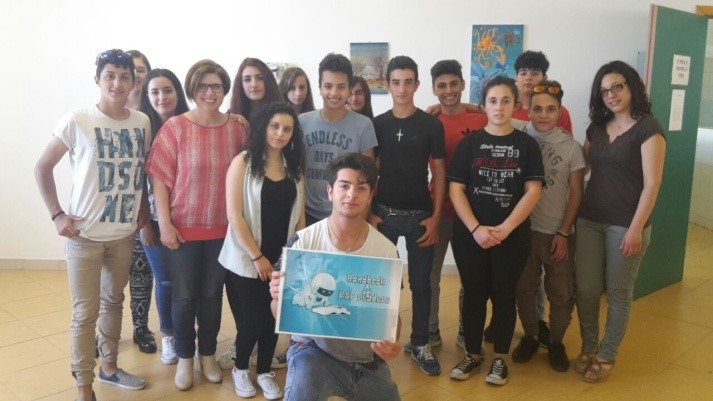
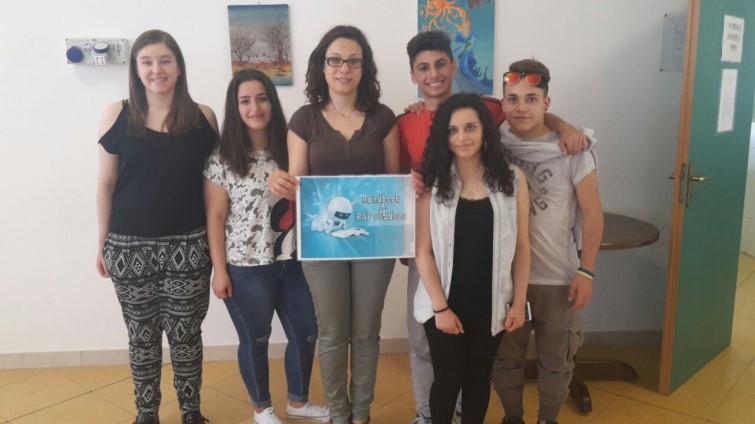
The most relevant facts stated by the students:
- When asked about the factors that influence reading, most of them said that they do not like reading or they find it useless, stressful, boring, whereas they prefer watching films, even dealing with school topics.
- They all stressed the importance of reading and clearly stated what encourages the reading (dictionary, imagination, new knowledge, social sensitivity, understanding of the world and problems ect.).
- To some of them reading out of school is part of the free time, while others point out their weaker concentration, laziness or dealing with some other things (playing instruments, sports).
- They all agreed that most of the books in the curriculum they do not like reading, but they prefer electoral books.
- The students emphasized the importance of exposure to reading in pre-school age - the role of parents and grandparents. Some of them did not have that experience.
- They often read without understanding (because they had to read it) and quickly adopted the strategy for downloading content from the internet.
- The group of students pointed out that interesting plot of what they read diminishes the importance of the number of pages.
- When it comes to e-books, the majority of teenagers reply that they rather pick up a paper book. The reason might follow the previous findings – paper books look better with a lot of colours and cool design. On the other hand, the e-book looks just boring when carrying around. Some students also like the feeling when browsing through paper pages.
- They have noticed the greater impact of digital tools on their reading motivation or understanding of content.
- They particularly emphasize that in the selection of texts, it is important to ensure that children and young people understand what they are reading, the usefulness of the topic they read about in their everyday life, and the attitude of the teacher towards their reading - gaining opportunities for progress.
- Those who do not like reading emphasize that the length of the material is related to understanding - if they do not understand what they read, they give up or skip it or they simply read summaries.
- Describing the length of reading material, they emphasized the organization of text - more smaller and shorter fragments, chapters that allow them better orientation and concentration on the text itself.
- They contrasted the length of the reading material to the interest in reading content, when the length is no longer important.
- Most students do not think that the scope of reading material may influence their willingness to read outside the classroom.
- When it comes to literary texts chosen by students to read outside the classroom, the number of pages is not as important as reading motivation, novels are their favorite literary form and they read extensive novels and romanesque cycles.
- Everyone agreed that the availability of topics and genres affects their willingness to read and that the teacher offers different texts and allows them to choose what they will read.
- They placed the beginning of their reading problems in the 5th grade of elementary school and emphasized that the approach of teachers to their reading was the most important for their motivation and willingness to read. The scope of reading material for most of them has become a problem already in the 4th and 5th grade of elementary school.
- They very much like the concept of "clever readers" (their understanding: it is not enough to think literally about the text they are talking about, but it is necessary to think about the context, about what is not in the text itself).
- Interesting books may be “long”, students will read them (for example, The book thief, To kill a Mockingbird).
- They pointed out that it is important for them to choose what to read, some of them have not yet found their genre, but many of them like crime stories and science fiction.
- Some of them pointed out the critical thinking during reading, especially contemporary media.
- They emphasized that reading changed their worldview and individual themes, as well as other perspectives on what they already had as a built-in attitude.
- Outlining factors that influence their motivation for reading, they also mentioned taboo themes.
- When pointing out the factors that influence reading motivation, RSP readers usually say that if the teacher did not involve them in the choice of a text, they would never read. They think that feeling free to choose topics and genres may influence their willingness to read
- Some students are more fearful to read out loud in front of a strict teachers; others do not care.
- They stressed that besides reading there are many other useful things that they enjoy in leisure time and that there are people who naturally like to read, but that their reading is greatly influenced by the teacher's approach.
- The function of digital tools is more visible in reading motivation and less in understanding of content.
- Interestingly, this research has shown that some students were read stories when they were children and they used to enjoy them. However, others were not.
- When asked what book they would burn if they could, the majority of them would throw away classics and schooltexts.
- When asked what a book is for them, their answers were: a universe to discover / a treasure rich in words we do not know that helps us enrich our vocabulary and better our oral communication / a reality that is felt by few people / a way to project myself into a different reality / a means to light the fireplace / a sort of fog where sentences and pictures float / a hobby (even if they say they have no time for reading)
- The students blame for their reluctance their peers saying that nobody around them reads therefore they do not see any point in reading.
- They also find it hard to see any purpose of reading – most often they answer they read because they have to do it for school.
- Another thing is that a lot of them feel lost in literature; they are not able to pick a book they might like. Therefore they expect the teachers to help them and recommend something; however, they would be happier to have some titles recommended by their friends who they trust more in this sense.
- The students confusion then contributes to a kind of fear from public libraries – places they rather avoid visiting because have no idea what to choose there.
- The purpose of reading and the factors affecting (or influencing) their reading, students, during the conversation, primarily related to school and grades and emphasized that you should be reading when alone, and they like to hang around and be surrounded by other people.
- They described in detail the impact of the teacher's attitude on willingness to read.
- The film and comics as well as the illustrations have been identified as the sources that most encourage their willingness to read.
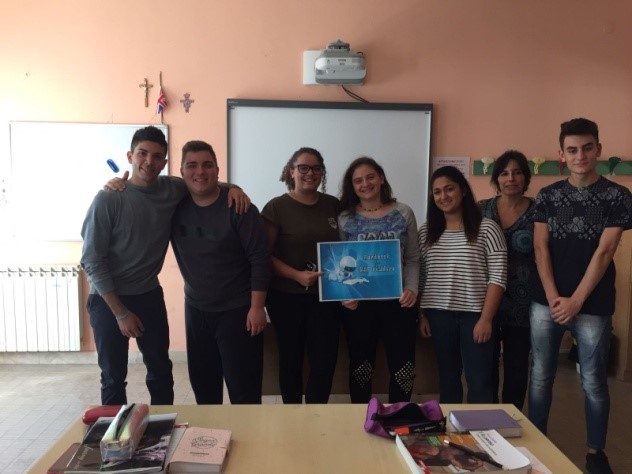
To work with NPL readers, the teachers brought out the following suggestions:
- At the beginning of the first grade of secondary school determine reading skills, motivation and willingness to read (interview, questionnaire etc.).
- Always start with the students, their attitudes, interests, and thoughts, and encourages them to suggest activities they consider as encouraging ones for reading.
- Collect information about what students are interested in, what they like and want to read.
- Offer a larger selection of texts outside the curriculum and provide assistance in the selection.
- Offer contemporary literary texts as an incentive and motivation to read compulsory texts.
- Talk to students about the difficulties they encounter while reading and individualize approach as much as possible.
- Use shorter texts of different genres and contemporary themes.
- It is necessary to nurture reading for pleasure
- Given the adolescent’s need for negotiation, it is wise to incorporate texts that foster critical literacy
- In the teaching process, make a greater correlation of additional materials with what is being read (video, film etc.).
- Introduce more activities aimed at raising awareness of reading and its importance in education and life.
- Record the activities and difficulties that hinder students when reading.
- Give students feedback on progress according to the plan of activities that are individualized.
- Focus on self-reflexion, lead students towards self-evaluation.
- The tests can serve as examples of preparing reading comprehension questions.
- Teachers should use their fantasy and creativity while preparing texts for reading.
- The students shouldn´t read what is strictly given by the national curriculum but teachers should adjust the texts to the needs and interests of the students.
- To create reading workshops.
- To have a reading role models for teens (teachers, parents or their classmates.)
- Reading aloud is still a good way of practising. Put the right resource in the right hands at the right time – teachers and library staff not only have to know their stock, but also know their students.
- Drama performance aids: dramatizing some parts of the novel can be useful means to get students closer to literature and may help them develop many cross-curricular competences such as learning to work in groups, organization and respect for rules etc.
- As a way to reach RSP readers, the teachers recommend offering them for example comic books or short stories. Some of them would also use drama techniques or playing musical instruments as a part of the activities connected with reading. They suggest creating costumes based on the reading as fashion is always important for teenagers, this activity might attract a big number of them.
- It is needed to refresh our school libraries and there can be a possibility to have not only teachers in our libraries but maybe to have some students there who are interested in reading.
- The teachers should remember that it is absolutely crucial to introduce the books in an attractive way. The teenagers will not do anything that is not cool. The same way they think about the book design – most of the respondents answered that they would prefer a book with nice illustrations rather than one without pictures.
- As a way to reach RSP readers, the teachers recommend offering them for example comic books or short stories. Some of them would also use drama techniques or playing musical instruments as a part of the activities connected with reading. They suggest creating costumes based on the reading as fashion is always important for teenagers, this activity might attract a big number of them.
- Five Evidence-Based Interventions can be used in teachers methodology (Acceleread/ Accelewrite, Peer Reading, Toe by Toe, SNIP, ARROW)
- Peers can be effective in raising reading standards, both through co-operative learning and through peer tuition.
- To observe and encourage the improvement of the students
- To implement different innovative methods wherever teachers can
- To work on the students’ self-concept
- To get over serious obstacles (social, cultural, economic, prejudice towards migrant students etc.)
- To increase the exchange of expertise, skill and information
- To use motivational literature and literature which are in accordance with the interest of our students (fantasy, literature with boy or girl protagonists).
- To start up a closer cooperation with the parents who can be factors positively enhancing willingness to read in the free time of the students.
At the school level
- Update the topic of RSP readers at school level and create specific activities.
- Increase the involvement of RSP readers in school-based activities (extracurricular activities – e.g. journalists' group, public cultural events at school).
- Develop co-operation with other teachers to better support RSP readers. Even little groups of teachers can manage to install a reading promotion programme if this group has convincing concepts, is supported by the principal, and motivates others to participate.
- The sort of cooperation between the headperson and the staff turned out to be a central element of good practice.
- The help for RSP must also come from a network of different experts who support the teachers. A team of special education teachers, school psychologists and social workers assists the teachers and can be contacted by the students and the teachers in all cass of health problems, psychological or social problems.
- Libraries need to focus on organising different cultural-educational and social activities, and most of all, to individual work with the students while selecting appropriate literature.
- Reinforce Teachers’ professional development. In order to teach students in the above-mentioned way, teachers must possess highly developed expertise in their subject. They must also be aware of the content specific demands on the students’ text comprehension skills, and they must be able to teach those skills.
General conclusions
By the comparison of the National methods and taking into consideration the results from the previously conducted project activities, as well as the individual partners' reports on General overviews and The State of the Art in each partners' country, the project partners concluded that the following causes are the most significant ones influencing RSP readers:
- Adolescent struggling readers are seen as non-readers without sufficient basic reading skills or reading motivation. This labelling is too simple and does not result in effective instruction.
- Traditional educational policies with selective educational systems with a very strict set of subjects and very prescriptive curricula.
- Achievement-orientated educational values and systems (poor readers have better opportunities in support orientated educational systems).
- Curricula for language arts instruction tie reading instruction almost exclusively to canonical literature and corresponding teaching material.
- Traditional instruction sequentially organized and centred on the teacher.
- The choice of materials and methods, the realization of the lessons and the final performance tests all refer back to the definitions of learning targets.
- The tests compare individual performance with previously defined requirements and leads to a ranking of the students (summative assessments).
- The primary goal of transmitting contents (learning of / curricula centred on contents) which demand the mastery of these contents for granting success to the students (performance orientated systems)
- An analysis of their personal strengths and weaknesses only takes place when the instructional sequence is finished, and thus comes too late for RSP Readers.
- The instructions only transmits subject-specific contents (learning of, instead of learning for /knowing what) and complies with externally defined aims and assessments.
- Instructional support does not accompany lessons and prevent failures but only reacts to them.
- The range and sustainability even of good practice suffers from lack of time.
- No systematic continuing reading training.
- Lack of specific remedial programmes.
- Deficits in teacher training and reading instruction at secondary schools meaning that the diagnostic competences of many teachers are not sufficiently developed and that they oftenly do not recognize “problem cases”. The teachers are left alone with the task of identifying poor readers.
- The selection of reading materials in instruction is not free from the surrounding educational
and cultural contexts. Usually, the choice is made on the basis of the national curriculum and national test requirements.
- The reading materials are not compulsory for students. They are obsolete and dull for the students in the 21st century.
- Developmental learning disorders like dyslexia, dysorthography and dyscalculia are diagnosis which should be taken in to reconsideration. There is a major misconception in this easely given etiquette.[1]
- Different level of cultural heritage that is passed down from parents to children, including cultural outlook, ability to express themselves, etc.
- Students socio-economic background. Pupils from higher social classes are in favour of a higher degree of "inherited" cultural capital than their lower-class classmates.
- New media and technologies that already have an equal position in the field of communication have significantly weakened the relationship with reading.
- Lack of family support.
Adolescent population who will acquire control over their reading and will be enabled to choose from books that address their needs and interests can spread their accomplishments among other young people by showing increased motivation for reading and by encouraging and supporting reading for pleasure. They will cultivate a culture of reading in long term by creating a reader's motivated environment among their population and further through their active grown-up life. It will not only encourage more and better reading, it will encourage the very poor who read to seek and receive support when and where needed. Once the process is set in motion, it should have a snowball effect. As new contacts are made, so the opportunities and means of spreading the word, reaching an ever-widening audience. This means it also will be a dynamic process that can be adapted to fully take advantage of each new audience and by finding new and appropriate activities as the need arises. Tangible results should produce wide impact on European educators and decision makers. Intangible results will reflect on the change of social and educational ethos whenever the RSP readers’ issues come into the focus of the educational policy decision makers.
Notification!
Individual Country Reports as well as Overall Report on above mentioned activities and their results are available on individual country project web pages.
[1] Today’s children are increasingly expected to progress in reading and writing at a standard speed and through one methodology. Struggling readers are often diagnosed as dyslexic. The diagnosis should be ‘struggling reader’ (Suchodoletz, W. Von,2003) and the focus should be on solving the problem.
- Details
- Published: 09 July 2018
- Created: 29 September 2018
- Last Updated: 29 September 2018
- Hits: 22245
Contact
X gimnazija ''Ivan Supek''
Ul. Vjekoslava Klaića 7
10000
Zagreb
E-mail: partners@handbook4rspreaders.org

